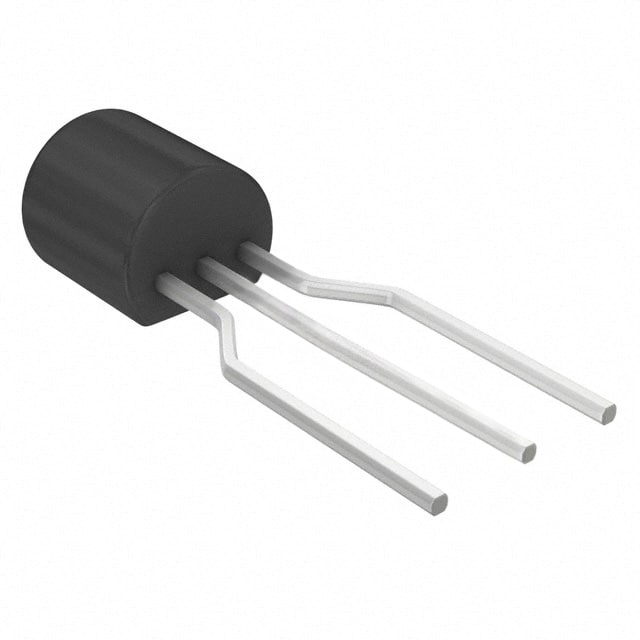2N3819_D74Z
Product Overview
Category
The 2N3819_D74Z belongs to the category of field-effect transistors (FETs).
Use
It is commonly used as an amplifier or switch in electronic circuits.
Characteristics
- Low noise figure
- High input impedance
- Suitable for high-frequency applications
Package
The 2N3819_D74Z is typically available in TO-92 packaging.
Essence
This FET is essential for amplifying weak signals and serving as a high-impedance switch in electronic devices.
Packaging/Quantity
It is usually packaged in reels or tubes, with quantities varying based on manufacturer specifications.
Specifications
- Maximum Drain-Source Voltage: 25V
- Maximum Gate-Source Voltage: -25V
- Continuous Drain Current: 50mA
- Power Dissipation: 350mW
- Operating Temperature Range: -55°C to 150°C
Detailed Pin Configuration
The 2N3819_D74Z has three pins: 1. Source (S) 2. Gate (G) 3. Drain (D)
Functional Features
- High input impedance
- Low noise performance
- Suitable for RF applications
Advantages
- Low noise figure
- High input impedance
- Versatile for high-frequency applications
Disadvantages
- Limited maximum voltage and current ratings
- Sensitivity to static electricity
Working Principles
The 2N3819_D74Z operates based on the field effect, where the voltage applied to the gate terminal controls the conductivity between the source and drain terminals.
Detailed Application Field Plans
The 2N3819_D74Z is widely used in the following applications: - Radio frequency amplifiers - Oscillators - Switching circuits - Low-noise preamplifiers
Detailed and Complete Alternative Models
Some alternative models to the 2N3819_D74Z include: - J310 - BF245 - MPF102 - 2N4416
In conclusion, the 2N3819_D74Z is a versatile field-effect transistor suitable for various high-frequency applications due to its low noise figure and high input impedance. However, it is important to consider its limitations in terms of voltage and current ratings, as well as its sensitivity to static electricity. When selecting an alternative model, factors such as pin compatibility and performance specifications should be carefully evaluated to ensure seamless integration into the intended circuit design.
Word Count: 324
Lista 10 Vanliga frågor och svar relaterade till tillämpningen av 2N3819_D74Z i tekniska lösningar
What is the 2N3819_D74Z transistor used for?
- The 2N3819_D74Z is a JFET (junction field-effect transistor) commonly used for high input impedance amplification and switching applications.
What are the key specifications of the 2N3819_D74Z transistor?
- The 2N3819_D74Z has a maximum drain-source voltage of 25V, a maximum gate-source voltage of 25V, and a maximum continuous drain current of 50mA.
How can I use the 2N3819_D74Z in an amplifier circuit?
- The 2N3819_D74Z can be used as a preamplifier in audio circuits due to its high input impedance and low noise characteristics.
Can the 2N3819_D74Z be used for switching applications?
- Yes, the 2N3819_D74Z can be used for signal switching due to its ability to control current flow between the drain and source terminals.
What are the typical applications of the 2N3819_D74Z in technical solutions?
- Typical applications include audio amplifiers, instrumentation amplifiers, analog switches, and voltage-controlled resistors.
What is the pinout configuration of the 2N3819_D74Z transistor?
- The 2N3819_D74Z has three terminals: gate (G), drain (D), and source (S).
What are the recommended operating conditions for the 2N3819_D74Z?
- The 2N3819_D74Z operates best within a temperature range of -55°C to 150°C and should be used with appropriate biasing and voltage levels.
Can the 2N3819_D74Z be used in radio frequency (RF) applications?
- Yes, the 2N3819_D74Z can be used in RF amplification and tuning circuits due to its high-frequency response and low noise characteristics.
Are there any common pitfalls or limitations when using the 2N3819_D74Z?
- Users should be mindful of static discharge, as JFETs are sensitive to electrostatic damage. Additionally, proper biasing and matching with other components are crucial for optimal performance.
Where can I find detailed datasheets and application notes for the 2N3819_D74Z?
- Datasheets and application notes for the 2N3819_D74Z can be found on semiconductor manufacturer websites, distributor platforms, and electronics component databases.


